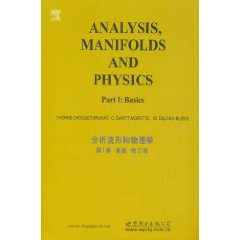內容簡介
 分析流形和物理學
分析流形和物理學《分析流形和物理學(第1卷):基礎(修訂版)》內容簡介:Alltooofteninphysicsfamiliarityisasubstituteforunderstanding,andthebeginnerwholacksfamiliaritywonderswhichisatfault:physicsorhimself.Physicalmathematicsprovideswelldefinedconceptsandtechni-quesforthestudyofphysicalsystems.Itismorethanmathematicaltechniquesusedinthesolutionofproblemswhichhavealreadybeenformulated;ithelpsintheveryformulationofthelawsofphysicalsystemsandbringsabetterunderstandingofphysics.Thusphysicalmathematicsincludesmathematicswhichgivespromiseofbeingusefulinouranalysisofphysicalphenomena.Attemptstousemathematicsforthispurposemayfailbecausethemathematicaltoolistoocrude;physicsmaythenindicatealongwhichlinesitshouldbesharpened.Infact,theanalysisofphysicalsystemshasspurredmanyanewmathematicaldevelopment.Considerationsofrelevancetophysicsunderliethechoiceofmaterialincludedhere.Anychoiceisnecessarilyarbitrary;weincludedfirstthetopicswhichweenjoymostbutwesoonrecognizedthatinstantgratifica-tionisashortrangecriterion.Wethenincludedmaterialwhichcanbeappreciatedonlyafteragreatdealofintellectualasceticismbutwhichmaybefartherreaching.Finally,thisbookgathersthestartingpointsofsomegreatcurrentsofcontemporarymathematics.Itisintendedforanadvancedphysicalmathematicscourse.
目錄
1. Review of Fundamental Notions of Analysis
A. Set Theory, Definition
1. Sets
2. Mappings
3. Relations
4. Orderings
B. Algebraic Structures, Definitions
I. Groups
2. Rings
3. Modules
4. Algebras
5. Linear spaces
C. Topology
1. Definitions
2. Separation
3. Base
4. Convergence
5. Covering and compactness
6. Connectedness
7. Continuous mappings
8. Multiple connectedness
9. Associated topologies
10. Topology related to other structures
11. Metric spaces
metric spaces
Cauchy sequence; completeness
12. Banach spaces
normed vector spaces
Banach spaces
strong and weak topology; compactedness
13. Hilbert spaces
D. Integration
1. Introduction
2. Measures
3. Measure spaces
4. Measurable functions
5. Integrable functions
6. Integration on locally compact spaces
7.Signed and complex measures
8. Integration of vector valued functions
9. L 'space
10. L'space
E. Key Theorems in Linear Functional Analysis
1. Bounded linear operators
2. Compact operators
3. Open mapping and closed graph theorems
Problems and Exercises
Problem 1: Clifford algebra; Spin(4)
Exercise 2: Product topology
Problem 3: Strong and weak topologies in L2
Exercise 4: Holder spaces
See Problem VI 4: Application to the Schr6dinger equation
II. Differential Calculus on Banach Spaces
A. Foundations
1. Definitions. Taylor expansion
2. Theorems
3. Diffeomorphisms
4. The Euler equation
5. The mean value theorem
6. Higher order differentials
B. Calculus of Variations
I. Necessary conditions forminima
2. Sufficient conditions
3. Lagrangian problems
C. Implicit Function Theorem. Inverse Function Theorem
1. Contracting mapping theorems
2. Inverse function theorem
3. Implicit function theorem
4. Global theorems
D. Di~erential Equations
1. First order differential equation
2. Existence and uniqueness theorems for the lipschitzian case
Problems and Exercises
Problem 1: Banach spaces, first variation, linearized equation
Problem 2: Taylor expansion of the action;Jacobifields; the
Feynman-Green function; the Van Vleck matrix;conjugatepoints; caustics
Problem 3: Euler-Lagrange equation: the small disturbance
equation: the soap bubble problem: Jacobi fields
III. Differentiable Manifolds, Finite Dimensional Case
A. Definitions
1. Differentiable manifolds
2. Diffeomorphisms
3. Lie groups
B. Vector Fields; Tensor Fields
I. Tangent vector space at a point
tangent vector as a derivation
tangent vector defined by transformation properties
tangent vector as an equivalence class of curves
images under differentiable mappings
2. Fibre bundles
definition
bundle morphisms
tangent bundle
frame bundle
principal fibre bundle
3. Vector fields
vector fields
moving frames
images under diffeomorphisms
4. Covariant vectors;cotangentbundles
dual of the tangent space
space of differentials
cotangent bundle
reciprocal images
5. Tensors at a point
tensors at a point
tensor algebra
6. Tensor bundles; tensor fields
C Groups of Transformations
I. Vector fields as generators of transformation groups
2. Lie derivatives
3. Invariant tensor fields
D. Lie Groups
1. Definitions; notations
2. Left and right translations; Lie algebra; structure constants
3. One-parameter subgroups
4. Exponential mapping; Taylor expansion; canonical coordinates
5. Lie groups of transformations; realization
6. Adjoint representation
7. Canonical form, Maurer——Cartan form
Problems and Exercises
Problem 1: Change of coordinates on a fiber bundle,
configuration space, phase space
Problem 2: Lie algebras of Lie groups
Problem 3: The strain tensor
Problem 4: Exponential map; Taylor expansion; adjoint map; left and
right differentials; Haar measure
Problem 5: The group manifolds of so(3) and SU(2)
Problem 6: The 2-sphere
IV. Integration on Manifolds
A. Exterior Digerential Forms
1. Exterior algebra
exterior product
local coordinates; strict components
change of basis
2. Exterior differentiation
3. Reciprocal image of a form (pull back)
4. Derivations and antiderivations
definitions
interior product
5. Forms defined on a Lie group
invariant forms
Maurer——Cartan structure equations
6. Vector valued differential forms
B. Integration
1. Integration
orientation
odd forms
integration of n-forms in R'
partitions of unity
properties of integrals
2. Stokes' theorem
p-chains
integrals of p-forms on p-chains
boundaries
V. Riemannian Manifolds Kahlerian Manifolds
VI Distributions
VII Differentiable Manifolds, Infinite Dimensionalvase
